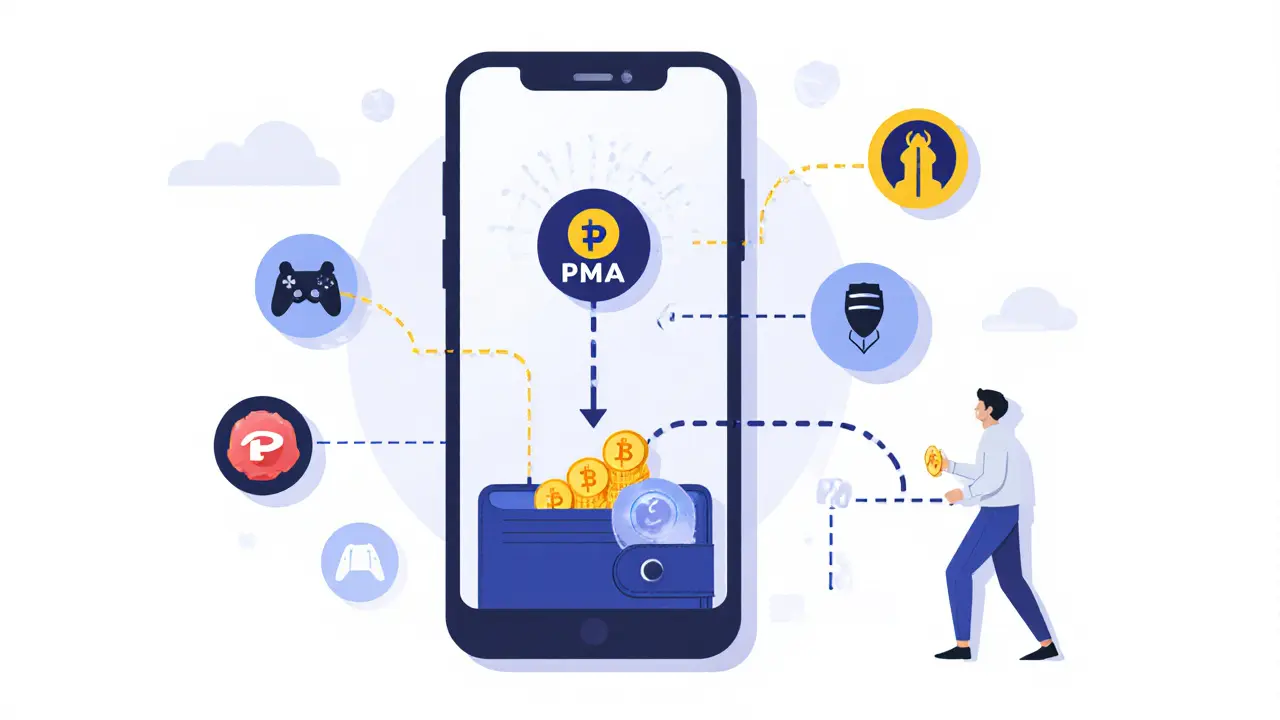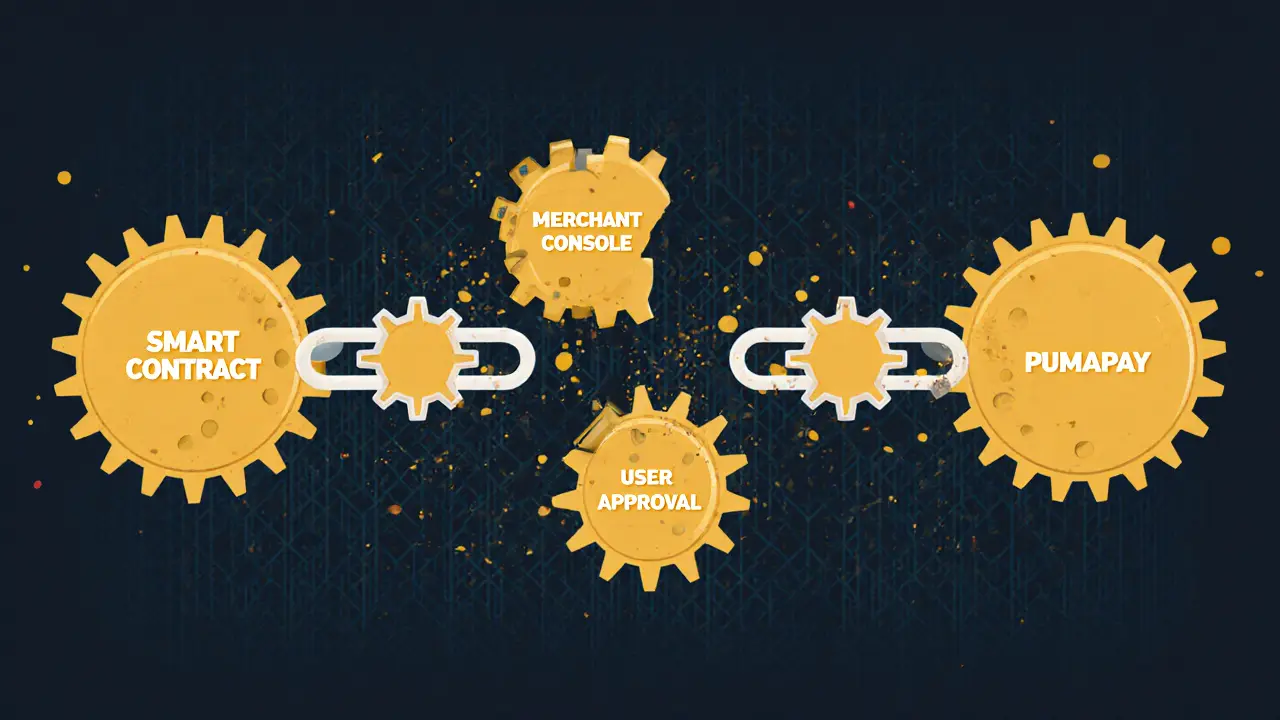
PumaPay (PMA) was never meant to be just another crypto coin. Launched in May 2018, it promised to fix one of the biggest headaches in cryptocurrency payments: recurring billing. While most crypto payments require you to manually send money each time - like paying for a Netflix subscription with Bitcoin - PumaPay wanted to flip the script. Instead of you pushing funds to a merchant, the merchant could pull payments directly from your wallet, based on rules set in smart contracts. Think of it like automatic bank debits, but on the blockchain.
How PumaPay Was Supposed to Work
The core idea behind PumaPay was simple but powerful: the PullPayment Protocol. Unlike BitPay or Coinbase Commerce, where you click "Pay with Crypto" and send funds yourself, PumaPay let merchants initiate payments. If you signed up for a monthly gaming subscription or adult content site, the merchant could automatically withdraw the agreed-upon amount from your wallet - no action needed on your part. This was done using something called a PullContract, a smart contract that stored payment terms like frequency, amount, and expiration.Everything ran on the Ethereum blockchain. PMA, the native token, was an ERC20 token - meaning it used Ethereum’s existing infrastructure. That made it easy to store in wallets like MetaMask, Trust Wallet, or Noone.io’s own PumaPay Wallet. The system had two main parts: on-chain (the smart contracts) and off-chain (the mobile app and business dashboard). Merchants used the business console to set up billing plans, while users managed their subscriptions and balances through the app.
Who Was It For?
PumaPay didn’t aim at regular online shoppers. It targeted high-risk industries that traditional payment processors refused to serve: adult entertainment, online gaming, VPN services, and crypto gambling sites. These businesses often get shut down by credit card companies due to chargebacks or regulatory pressure. Cryptocurrency was their lifeline - but even crypto payment processors like BitPay wouldn’t handle recurring billing reliably. PumaPay claimed to fill that gap.For these merchants, the appeal was clear: no chargebacks, no intermediaries, and no approval process. The protocol was free to use, and the tools - wallet, SDK, business console - were designed to be plug-and-play. All you needed was an Ethereum-compatible system. No complex API integration. No bank account. Just a smart contract and a wallet.
Why It Failed
Here’s the brutal truth: PumaPay never gained traction. Its all-time high price was $0.00164. As of November 2025, it trades around $0.000002 - a drop of over 99.9%. That’s not just a market correction. That’s a collapse.Why? Three big reasons:
- No real adoption. Despite targeting high-risk industries, there are zero public case studies, merchant testimonials, or usage stats. No major adult site or gaming platform ever publicly integrated PumaPay.
- Too much friction for users. Asking users to approve pull requests from unknown merchants is a security nightmare. Most people won’t grant a merchant the right to pull money from their wallet - even if it’s automated. The trust barrier was too high.
- Competition got better. While PumaPay was stuck in development, other solutions emerged. Crypto payment gateways like Crypto.com Pay and NOWPayments added recurring billing features. Stablecoins and fiat on-ramps made it easier for merchants to accept crypto without dealing with volatile tokens like PMA.
The technical design was clever, but execution was nonexistent. The team, led by Yoav Dror and Aristos Christofides, stopped releasing updates after 2020. No roadmap. No new features. No community engagement. The website became a ghost town. Even the official GitHub repository hasn’t been updated since 2021.

What’s Left Today?
Today, PMA is a dead asset. Trading volume is negligible. Exchanges like KuCoin and BitMart still list it, but you won’t find it on Coinbase, Binance, or Kraken. The price predictions for 2026? Between $0.000680 and $0.000770 - still 99.9% below its peak. Technical analysts say the next resistance level is $0.0000035 - a level it hasn’t touched in years.Security-wise, the only advice left is generic: use 2FA, never share your private key, keep your wallet updated. Noone.io’s wallet guide is the last remaining piece of official documentation. There are no forums, no Reddit threads, no Discord communities actively discussing PumaPay. The project is functionally dead.
Was It Ever Real?
Yes - technically. The PullPayment Protocol was a legitimate innovation. It solved a real problem: recurring crypto payments. Many developers at the time called it "the first DeFi payment protocol for subscriptions." But innovation without adoption is just a whitepaper. The team built a beautiful engine - but never put it in a car.Compare it to something like Chainlink. Chainlink also started as a niche idea - bringing real-world data to blockchains. But it got real partnerships, real use cases, and real developers. PumaPay had none of that. It was a solution looking for a problem that never showed up.

Should You Buy PMA Today?
Absolutely not.If you’re looking to invest in crypto payments, look at established players like Polygon, Stellar, or even Bitcoin Lightning Network. They have active development, real merchants, and growing usage. PMA has none of that. It’s a tombstone with a ticker symbol.
Some people buy it hoping for a miracle rebound. But with a 78% annual decline against USD and an 87% drop against Bitcoin over the last year, this isn’t a speculative play - it’s a graveyard.
What You Can Learn From PumaPay
PumaPay’s story is a cautionary tale for anyone entering crypto:- Great tech ≠ successful product. You need users, not just smart contracts.
- Targeting "high-risk" markets doesn’t guarantee adoption - it often means isolation.
- Without active development and marketing, even the most clever ideas die quietly.
- Don’t fall for the hype of "first-ever" claims. Execution matters more than innovation.
PumaPay isn’t a coin you hold. It’s a lesson. One that shows how easily crypto projects can vanish - even when they start with solid ideas.
Is PumaPay (PMA) still active?
No, PumaPay is not active. The project stopped updating in 2021. The official website is static, the GitHub repo is abandoned, and the development team has not released any new information since 2020. The PMA token still exists on exchanges, but there is no ongoing development, community support, or merchant adoption.
Can I still use PumaPay to make payments?
No. Even if you have PMA tokens in your wallet, there are no live merchants using the PumaPay system. The business console, SDK, and payment infrastructure are offline. The protocol’s pull-payment mechanism no longer functions in the real world.
Why did PumaPay fail when it had a good idea?
It failed because no one used it. The concept of pull-based crypto payments was innovative, but the team never built trust with users or merchants. They didn’t partner with any real businesses, didn’t market effectively, and didn’t respond to user concerns. Without adoption, even the best technology becomes irrelevant.
What happened to the PumaPay team?
The founding team - including CEO Yoav Dror and CTO Aristos Christofides - disappeared from public view after 2020. Their LinkedIn profiles show no recent activity related to PumaPay. No interviews, no blog posts, no conference appearances. The project was effectively abandoned.
Is PMA worth holding as an investment?
No. PMA has lost 99.9% of its value since its peak. Trading volume is near zero, and there is no indication of recovery. Holding PMA is not an investment - it’s a sunk cost. If you own it, consider it a learning experience, not an asset.
Can I convert PMA to cash?
Technically yes - you can sell PMA on exchanges like KuCoin or BitMart. But because trading volume is so low, you’ll likely get a terrible price. There’s no liquidity. Selling may take days, and you’ll probably lose most of what’s left in your holdings.
Is PumaPay built on its own blockchain?
No. PumaPay was always an ERC20 token on the Ethereum blockchain. Although the team mentioned plans to launch its own blockchain in the future, that never happened. All transactions still occur on Ethereum.
What wallets support PMA?
PMA can be stored in any Ethereum-compatible wallet that supports ERC20 tokens - like MetaMask, Trust Wallet, or the now-defunct PumaPay Wallet. However, since the project is dead, there’s no official support or updates. Use standard Ethereum wallet security practices: never share your private key, enable 2FA, and keep your recovery phrase offline.
dhirendra pratap singh
12 11 25 / 11:20 AMPumaPay was a dumpster fire wrapped in a whitepaper 🤡 I mean, who lets strangers pull money from their wallet? That’s not innovation, that’s financial Russian roulette. And now it’s worth less than my expired energy drink. RIP, PMA. You had potential, but you were too lazy to even build a Discord server.
Ashley Mona
13 11 25 / 01:59 AMI remember when PumaPay dropped. I was so excited - finally, a solution for my Patreon-style crypto subscriptions! But then I realized... no one was using it. Not even the adult sites that supposedly needed it. 😔 It’s heartbreaking when good tech dies because no one bothered to explain it to normal humans. Maybe they thought ‘smart contracts’ would magically attract users. Spoiler: they didn’t.
Edward Phuakwatana
13 11 25 / 06:12 AMLet’s be real - PumaPay wasn’t a failure of tech, it was a failure of ecosystem design. The PullPayment Protocol was elegant, yes - but crypto adoption isn’t about clean architecture. It’s about frictionless UX, social proof, and psychological safety. People don’t want to ‘approve pull requests’ from strangers. They want to click ‘Subscribe’ and forget about it. That’s why NOWPayments and Crypto.com Pay won. They didn’t reinvent the wheel - they just made it roll smoother. PumaPay tried to build a jet engine… in a bicycle shop.
Suhail Kashmiri
14 11 25 / 02:40 AMThis is why India should never trust crypto projects from foreign devs. They come here with fancy slides, promise moonshots, then vanish. PumaPay? More like PumaScam. No one even tried to localize the app for non-English speakers. Zero outreach. Zero transparency. Just another Silicon Valley ego trip with an ERC20 token attached. Stay away from all these ‘first-ever’ projects - they’re always the last to exist.
Kristin LeGard
14 11 25 / 10:29 AMI don’t care how ‘clever’ the smart contract was - if you’re targeting adult sites and crypto gambling, you’re already doomed. American banks won’t touch you, regulators will crush you, and normal users won’t risk their wallets. This wasn’t a tech problem. It was a moral one. You can’t build a payment system on sin and expect it to last. PumaPay didn’t fail - it was executed by the market.
Arthur Coddington
14 11 25 / 16:00 PMI used to think crypto was about freedom. Then I saw PumaPay. Now I think it’s just capitalism with more buzzwords. The team had a good idea, sure. But they didn’t build a product. They built a PowerPoint. And now? It’s a tombstone. I’m not mad. I’m just… tired. Like I wasted 30 minutes reading this and now I have to go drink something strong.
Phil Bradley
15 11 25 / 17:29 PMYou know what’s wild? PumaPay was trying to solve a problem that didn’t exist for 99% of people. Who even wants automatic crypto debits? I can’t even get my mom to use Venmo. And now you want her to approve a smart contract that lets some shady gaming site pull money out? Nah. This wasn’t innovation - it was overengineering. The real win is making crypto simple. Not clever. Simple.
Stephanie Platis
15 11 25 / 18:18 PMThe failure of PumaPay is not merely a case of poor execution - it is, unequivocally, a catastrophic abandonment of user-centric design principles. The team assumed that technological superiority would compel adoption. This is a fundamental misunderstanding of human behavior. Users do not adopt technologies because they are ‘clever’; they adopt them because they are intuitive, trustworthy, and socially validated. PumaPay had none of these. Therefore, its demise was not only predictable - it was inevitable.
Michelle Elizabeth
16 11 25 / 09:01 AMI read this whole thing because I thought it’d be funny. It wasn’t. It was just… sad. Like watching a museum exhibit labeled ‘What Could Have Been.’ PumaPay had the aesthetic of a startup that hired a designer from Dribbble and a dev from Stack Overflow. No soul. No story. Just code. And now? It’s digital dust.
Joy Whitenburg
17 11 25 / 19:29 PMi just wanna say… i had pma in my wallet for like 6 months and forgot about it. then i checked last month and it was worth $0.03. i sold it for 2 bucks and bought a pizza. honestly? best crypto investment i ever made. thanks, pumapay. you gave me pepperoni 🍕❤️
Kylie Stavinoha
19 11 25 / 09:03 AMThe PumaPay saga is emblematic of a broader cultural phenomenon in Web3: the romanticization of technical novelty over human utility. In Japan, we have a concept called 'monozukuri' - the art of making things with care and purpose. PumaPay had the form of innovation but lacked the spirit. It was not built for people. It was built for whitepapers. And in the end, whitepapers do not pay bills.
Diana Dodu
20 11 25 / 08:56 AMLet’s be honest - this was a crypto exit scam disguised as a protocol. Why else would the team vanish after 2020? No press releases. No updates. No accountability. And now the token is worth less than a meme coin created by a 14-year-old on Discord. This isn’t failure. This is fraud. Someone got rich off this. And the rest of us? We’re left holding digital toilet paper.
Raymond Day
21 11 25 / 17:56 PMI still have a screenshot of the PumaPay pitch deck. Looked like Apple met Blockchain. 🤩 But here’s the kicker - they never even got a single paying merchant. Zero. Nada. Zip. And yet they raised millions? That’s not incompetence. That’s a con. The team didn’t build a payment system. They built a fundraising engine. And now? The engine’s dead. But the money? Gone.
Noriko Yashiro
23 11 25 / 07:11 AMI worked in fintech in London before moving to Tokyo. PumaPay’s model was technically sound - but they ignored one thing: trust. No one in Asia or Europe will let a random merchant pull funds without KYC, without verification, without a brand they recognize. PumaPay thought ‘blockchain’ was enough. It wasn’t. It’s like selling a car without wheels and calling it ‘innovative.’
Atheeth Akash
25 11 25 / 00:33 AMi read this and felt nothing. puma pay was just another crypto project that thought it was special. the tech was cool, sure. but no one cared. thats the truth. we dont need more solutions. we need more users. and puma pay never got any. peace
James Ragin
25 11 25 / 22:56 PMI’ve been following crypto since 2017. PumaPay was never the problem. The real problem is that the entire industry is a government-backed psyop to distract us from the real financial collapse. The Fed knows this. The banks know this. And PumaPay? Just another pawn in the game. They let it rise so we’d all chase ghosts while they print trillions. Don’t be fooled. This isn’t about crypto. It’s about control.
Michael Brooks
27 11 25 / 06:15 AMI used to think PumaPay had a shot. Then I checked their GitHub. One commit in 2021. Zero issues. Zero PRs. Zero contributors. That’s not a dead project. That’s a corpse with a website. If you’re building a payment system, you need to be active. Daily. Hourly. PumaPay was a ghost. And ghosts don’t get paid.
David Billesbach
28 11 25 / 18:33 PMPumaPay’s real crime wasn’t failing - it was pretending to be something it wasn’t. They didn’t just sell a token. They sold a fantasy. A fantasy that you could pay for porn with crypto and not feel guilty. A fantasy that you could outsmart the banks. A fantasy that someone, somewhere, actually cared. The truth? No one cared. And now the only thing left is a ticker symbol and a bunch of people who still check their wallets every morning, hoping for a miracle. It’s not a coin. It’s a cult.
Andy Purvis
29 11 25 / 09:21 AMI think we’re too harsh on PumaPay. They tried something different. Most projects just copy each other. They made a pull-based system - weird, yes, but brave. Maybe the timing was off. Maybe the UX sucked. But the idea wasn’t stupid. We should remember the attempt, not just the failure. The crypto space needs more dreamers, not just critics.
Ruby Gilmartin
30 11 25 / 22:39 PMLet me break this down for you: PumaPay’s tokenomics were a joke. 10B supply, 0 liquidity, 0 utility. The team raised $15M in 2018. The market cap peaked at $120M. Now? $200k. That’s a 99.98% destruction of value. That’s not a failed project. That’s a financial massacre. And you? You’re still reading about it? Get a life.
Edward Phuakwatana
1 12 25 / 19:56 PMActually, I think PumaPay’s biggest mistake was not building a bridge to fiat. If they’d partnered with a stablecoin issuer - like USDC - and let merchants auto-pay in stablecoins while users held PMA as governance, they might’ve survived. Instead, they forced everyone to hold volatile PMA. That’s like selling a subscription service and making customers pay in Bitcoin. No wonder no one signed up.